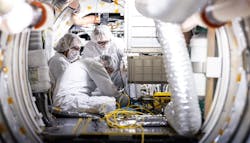Sierra Space's Dream Chaser spaceplane completes key NASA test
LOUISVILLE, Colo. – Sierra Space in Louisville, Colo. announced the completion of its Joint Test 10B milestone with the National Aeronautics and Space Administration (NASA), which marks the advancement of the development of its commercial Dream Chaser spaceplane ahead of a planned mission to deliver cargo to the International Space Station (ISS).
The test confirmed Dream Chaser's ability to power on, cool payloads with air circulation, and exchange data with multiple powered payloads inside its pressurized cabin. These capabilities are necessary for the spacecraft’s role in ISS resupply missions.
"Tests like these are critical demonstrations of the capabilities of the Dream Chaser spaceplane and confirm our ability to handle specialized payloads such as vital scientific research that will be integral to our mission to the ISS," said Pablo Gonzalez, Sierra Space's vice president of crew and cargo transportation systems.
The test verified that Dream Chaser can provide power within a specific voltage range and maintain environmental conditions required for payloads. It also ensured that data from both the vehicle and its payloads could be monitored in Sierra Space’s mission control center in Louisville, Colorado, and at NASA’s Marshall Space Flight Center in Huntsville, Alabama.
Engineers evaluated three payloads expected to fly on Dream Chaser’s first mission, DCC-1:
- Polar, a cryogenic preservation system developed by the University of Alabama at Birmingham and managed by NASA’s Cold Stowage Lab. It is designed to store scientific samples on the ISS and visiting spacecraft at temperatures ranging from -95°C to +10°C.
- Powered Ascent Utility Locker (PAUL), a payload facility developed by Space Tango to support two CubeLab experiments that require power during launch, often for biological research such as cell and tissue cultures.
- NASA’s Single Stowage Locker, a standard storage system for experiments and other payloads aboard Dream Chaser.
"Space Tango’s recent integration testing with the Sierra Space Dream Chaser went well and all teams were very happy with the results," said Anne Currin, Space Tango’s director of mission management. "We appreciate the steps the Sierra Space team has taken to get both the vehicle and Space Tango ready for a successful flight. It’s been exciting to see this come together as we count down to a maiden flight that is scheduled to increase access for payload delivery to the International Space Station."

Jamie Whitney
Jamie Whitney joined the staff of Military & Aerospace Electronics and Intelligent Aerospace. He brings seven years of print newspaper experience to the aerospace and defense electronics industry.
Whitney oversees editorial content for the Intelligent Aerospace Website, as well as produce news and features for Military & Aerospace Electronics, attend industry events, produce Webcasts, oversee print production of Military & Aerospace Electronics, and expand the Intelligent Aerospace and Military & Aerospace Electronics franchises with new and innovative content.

